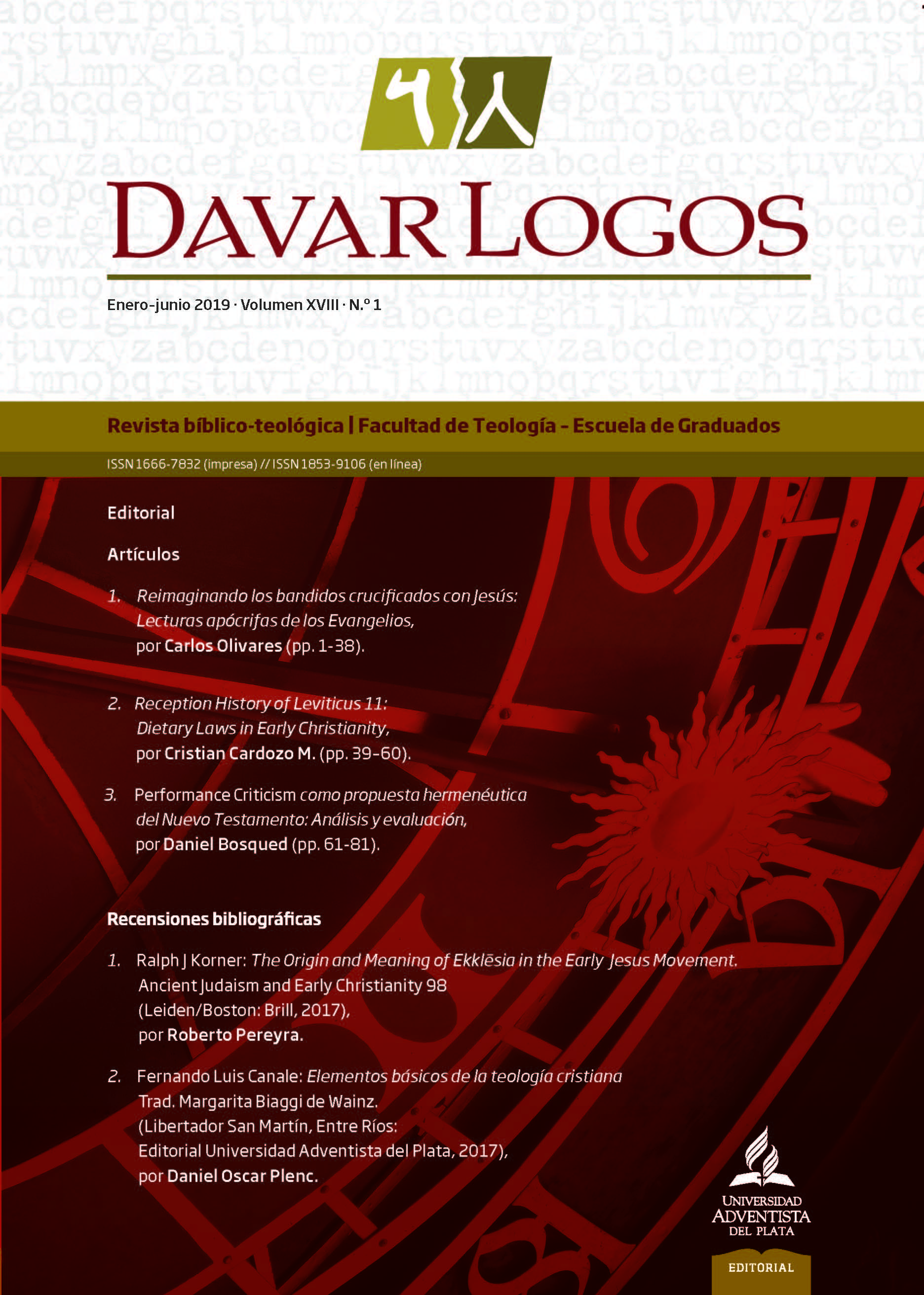Reimaginando los bandidos crucificados con Jesús
Lecturas apócrifas de los Evangelios
DOI:
https://doi.org/10.56487/wkxzxe44Palabras clave:
Evangelio de Lucas — Crítica textual del Nuevo Testamento — Apócrifos del Nuevo Testamento — Folclore cristianoResumen
Los evangelios sinópticos y Juan indican que Jesús es crucificado entre dos bandidos. El Evangelio de Lucas, sin embargo, amplía el relato y narra cómo uno de ellos se arrepiente, en tanto el otro es condenado. El propósito de este artículo es exponer concisamente cómo la vida de estos dos bandidos es reimaginada a través de los años. Las fuentes examinadas son agrupadas en tres secciones: (a) manuscritos del Nuevo Testamento, (b) apócrifos del Nuevo Testamento, y (c) documentos no canónicos del Nuevo Testamento.
El estudio describe el desarrollo de la historia de estos dos hombres, notando las similitudes y contradicciones que existen entre las fuentes estudiadas.
Descargas
Referencias
Entre los que se han abocado previamente a estudiar y exponer este tema, se pueden mencionar,
por ejemplo, a Anna Jameson y Elizabeth Eastlake, The History of Our Lord as Exemplified in
Works of Art, vol. 2 (Londres: Longman, Green, Longman, Roberts, & Green, 1864), 164-166;
Morton S. Enslin, “Hagiographic Mistletoe”, JR 25 (1945): 13-24; Bruce Metzger, “Names for
the Nameless in the New Testament. A Study in the Growth of Christian Tradition”, en New
Testament Studies: Philological, Versional, and Patristic, NTTS 10 (Leiden, NL: Brill, 1980),
-38; y Mary Dzon, “Out of Egypt, Into England: Tales of the Good Thief for Medieval
English Audiences”, en Devotional Culture in Late Medieval England and Europe: Medieval
Church Studies, Stephen Kelly y Ryan Perry, eds. (Turnhout, BE: Brepols Publishers, 2014),
-241.
Pareciera, como sugiere Peter Widdicombe, que los padres de los primeros siglos se enfocaron
más en subrayar la gracia de Dios que en centrarse en los personajes [“The Two Thieves of Luke
:32-43 in Patristic Exegesis”, StPatr 34 (2006): 273-277]. Cf. Enslin, “Hagiographic Mistle toe”, 14-16.
Este trabajo no tiene relación hermenéutica con la propuesta del Wirkungsgeschichte (o historia
de la recepción), el que, cuando es pensando metodológicamente, se centra en reconocer el valor
universal, e incluso canónico, de las interpretaciones diacrónicas, sea cual sea esta. Para esto, el
Wirkungsgeschichte asume una visión subjetiva y de desarrollo histórico, y también comunal en
la comprensión del texto bíblico [e.g., Mark Knight, “Wirkungsgeschichte, Reception History,
Reception Theory”, JSNT 33 (2010): 137-146; Heikki Räisänen, “The Effective ‘History of the
Bible: A Challenge to Biblical Scholarship”, SJT 45 (1992): 303-324; Ulrich Luz, “The Contri bution of Reception History to a Theology of the New Testament”, en The Nature of New Testa ment Theology: Essays in Honour of Robert Morgan, Christopher Rowland y Christopher Tuc kett, eds. (Malden, MA: Blackwell, 2006), 123-134; Mark W. Elliott, “Effective-History and
the Hermeneutics of Ulrich Luz”, JSNT 33 (2010): 161-173]. A diferencia del Wirkungsgeschi chte, la función de este trabajo es revelar ideas y observar un desarrollo redaccional en el uso de
fuentes bíblicas u otras. Por tanto, el artículo no procura avalar ni criticar el contenido ni la
evolución o el mensaje de las fuentes estudiadas.
Cf. Donald A. Hagner, The New Testament: A Historical and Theological Introduction (Grand
Rapids, MI: Baker Academic, 2012), 164, 184, 194, 212-214, 228, 246-248, 256, 290-291.
Excede a los límites de este trabajo la inclusión de obras artísticas, sean estas profesionales o no,
realizadas en el período en estudio (ii-xv d. C.). Para esto, recomiendo ver Jameson y Eastlake,
History of Our Lord, 164-171.
Cf. NA28; UBS5
.
Entre ellas, siriacas, cópticas, armenias, georgianas, etiópicas, latinas, góticas y eslavas. Ver Bruce
M. Metzger, The Early Versions of the New Testament: Their Origin, Transmission, and Limita tions (Oxford, GB: Clarendon Press, 2001); Kurt Aland y Barbara Aland, The Text of the New
Testament, trad. Erroll Rhodes (Grand Rapids, MI: Eerdmans, 1995), 185-221.
Enslin, “Hagiographic Mistletoe”, 16; Bruce Metzger, “Names for the Nameless”, 33.
Bruce M. Metzger y Bart D. Erhman, The Text of the New Testament: Its Transmission, Corrup tion, and Restoration (Nueva York: Oxford University Press, 2005), 103; Metzger, Early Versions
of the New Testament, 296; 313; 341; D. C. Parker, An Introduction to the New Testament Ma nuscripts and their Texts (Cambridge, GB: Cambridge University Press, 2008), 81.
Ver NA28. Desde una perspectiva crítico textual, se asume que en la traducción al latín de Marcos
y Lucas, el códice Colbertinus muestra rastros notorios de la Vetus Latina. Esta característica es
menos evidente en el texto de Mateo, el cual, junto a Juan, exhibe trazos de la Vulgata. Ver León
Vaganay y Christian-Bernard Amphoux, An introduction to New Testament textual criticism,
trad. Jenny Heimerdinger (Cambridge, GB: Cambridge University Press, 1991), 28; Metzger,
Early Versions of the New Testament, 313; Metzger y Erhman, Text of the New Testament, 103.
Para una transcripción del texto, ver J. Belsheim, Codex colbertinus parisiensis. Qvatuor Evangelia
ante Hieronymum latine translata post editionem Petri Sabatier cum ipso codice collatam, denuo
edidit J. Belsheim (Christianiae, DK: Sumptibus Librariae Alberti Cammermeyeri, 1888), 38.
Cf., NA28; Constantinus Tischendorf, Novum Testamentum Graece, Editio octava critica maior,
vol. 1 (Leipzig, DE: J. C. Hinrichs, 1869-1894), 200; Bruce Metzger, A Textual Commentary on
the Greek New Testament, 2.ª ed. (Stuttgart, DE: United Bible Societies, 2000), 57-58.
Belsheim, Codex colbertinus parisiensis, 63. Cf., NA28; Tischendorf, Novum Testamentum Grae-m
ce, 1:39; Bruce Metzger, A Textual Commentary on the Greek New Testament (Londres: United
Bible Societies, 1971), 118-119. Esta referencia desaparece en la segunda edición.
Metzger, Early Versions of the New Testament, 300.
Para una transcripción del texto, ver Thomas Kingsmill Abbott, Evangeliorum versio antehier onymiana: ex Codice Usseriano (Dublinensi), adjecta collatione Codicis Usseriani alterius accedit
versio Vulgata sec. Cod. Amiatinum, cum varietate Cod. Kenanensis (Book of Kells) et Cod.
Durmachensis (Book of Durrow) (Dublín, IE: Hodges, 1884), 647. Cf. Metzger, Textual Com mentary on the Greek New Testament, 153.
Respecto al estado defectuoso del códice, “[t]ime and either fire or water have injured it so much
that there is not a single perfect page; it is defective at the beginning and at the end”. Robert
Henry Murray, A Short Guide to Some Manuscripts in the Library of Trinity College, Dublin,
Helps for Students of History 32 (Londres: Society for Promoting Christian knowledge, 1920),
Cf. John K. Ingram, “Opening Address”, en Transactions and Proceedings of the Library Asso ciation of the United Kingdom, Seventh Annual Meeting, Dublin 1884, ed. Ernest C. Thomas
(Londres: Charles Whittingham & Co., 1890), 18.
Ver Abbott, Evangeliorum versio antehieronymiana, 647.
E. A. Loew, “The Date of Codex Rehdigeranus”, JTS 14 (1913): 569-570; Metzger, Early Ver sions of the New Testament, 299; Vaganay y Amphoux, Introduction to New Testament, 52.
Para una transcripción del texto, ver Heinrich Joseph Vogels, Codex Rehdigeranus (Die vier
Evangelien nach der lateinischen handschrift R169 der Stadtbibliothek Breslau), Collectanea bi blica latina 2 (Roma: F. Pustet, 1913), 248 (fol. 244 [251]). Cf., NA28; Tischendorf, Novum
Testamentum Graece, 1:710; Metzger, Textual Commentary on the Greek New Testament, 153.
Ver Vogels, Codex Rehdigeranus, 248-249.
James Rendel Harris, “A Further Note on the Names of the Two Robbers in the Gospel”, The
Expositor 6 (1900): 305-308.
Descargas
Publicado
Número
Sección
Licencia
Derechos de autor 2019 DavarLogos

Esta obra está bajo una licencia internacional Creative Commons Atribución-NoComercial-CompartirIgual 4.0.





